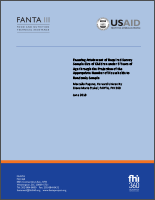 When designing a household survey where the key indicators that drive the overall sample size of the survey are at the individual child level (such as for the stunting indicator), the first step is to determine how large a sample of households is necessary to achieve the required sample size of children. Two methods have typically been used for this purpose—the Magnani Method and the Stukel-Deitchler Method. However, it is broadly acknowledged that the former method underestimates the number of households to sample while the latter overestimates the number of households to sample.
When designing a household survey where the key indicators that drive the overall sample size of the survey are at the individual child level (such as for the stunting indicator), the first step is to determine how large a sample of households is necessary to achieve the required sample size of children. Two methods have typically been used for this purpose—the Magnani Method and the Stukel-Deitchler Method. However, it is broadly acknowledged that the former method underestimates the number of households to sample while the latter overestimates the number of households to sample.
In this paper two new approaches to projecting the number of households to sample in order to achieve a required target sample size of eligible children are suggested: the Poisson Method and the Kappa Prediction Method. Data from 18 typical household surveys are used to simulate the prediction behaviors for all four methods. The paper summarizes the results of the four methods and recommends that the Poisson Method, at 95 percent confidence level, be adopted for future use.


